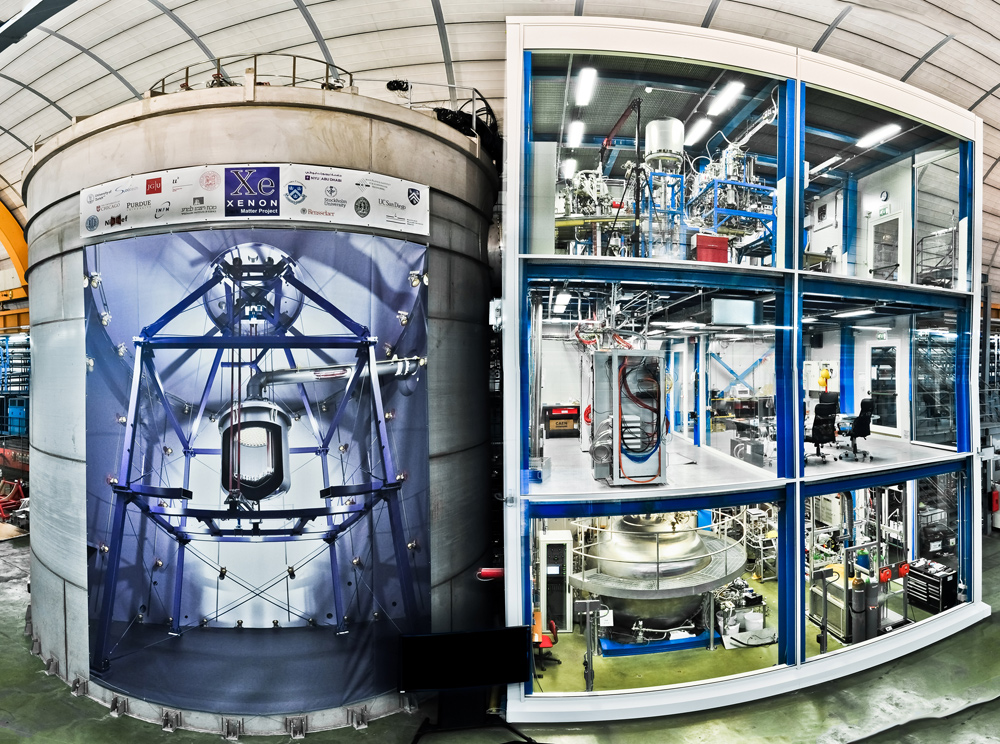The World's Most Sensitive Dark Matter Detector Is Now Up and Running

After three years of construction, the world's most sensitive dark matter experiment is online, and scientists report that the detector is operating as designed.
The XENON1T detector hasn't found any dark matter particles yet, but it has carried out a 30-day science run, and project scientists are optimistic about the future.
"The best result on dark matter so far! … and we have just started!" the XENON1T team said in a statement. [Gallery: Dark Matter Throughout the Universe]
XENON1T is looking for the microscopic fireworks created by weakly interacting massive particles (WIMPs) crashing into xenon atoms. WIMPs are hypothetical particles that many scientists think are a primary component of dark matter.
Astronomical observations have confirmed that only about 15 percent of the material universe is composed of "ordinary" (or "baryonic") matter; nearly 85 percent is mysterious dark matter, which cannot be observed directly by telescopes. But dark matter's gravity can be measured indirectly via its effects on galaxy clusters and the rotation rates of galaxies, so we know it's out there.
Because WIMPs are so "weakly interacting" — that is, they cannot interact with normal matter via the electromagnetic, strong or weak forces — XENON1T can detect them only by looking out for lucky collisions between WIMPs and atoms in a chamber filled with pure liquid xenon cooled to minus 139 degrees Fahrenheit (minus 95 degrees Celsius).
When a direct collision occurs, the liquid scintillates (flashes), and there is ionization in the liquid. By studying these flashes, scientists can then determine the exact nature of the colliding particles.
Get the Space.com Newsletter
Breaking space news, the latest updates on rocket launches, skywatching events and more!
But to detect these extremely weak flashes in the Liquid Xenon Time Projection Chamber (LXeTPC), the surrounding natural radiation levels in the cavern must be kept to a minimum. To achieve maximum shielding, the LXeTPC is submerged in a massive water tank that's the size of the neighboring three-story building that contains the auxiliary equipment to support the experiment.
The water tank and the natural shielding provided by the tons of overlying rock still aren't enough to ensure minimal radiation interference, however.
All materials can produce small quantities of radiation. So, to achieve its record radioactive "silence," the detector's materials had to be selected carefully, and the liquid xenon itself was meticulously processed, the researchers said. These steps were "necessary to listen … for the very weak voice of dark matter," they added in the statement.
The first XENON1T results have been made available on the online preprint service arXiv.org.
"WIMPs did not show up in this first search with XENON1T, but we also did not expect them so soon!" project spokesperson Elena Aprile, a professor of astrophysics at Columbia University, said in the statement.
"The best news is that the experiment continues to accumulate excellent data, which will allow us to test quite soon the WIMP hypothesis in a region of mass and cross-section with normal atoms as never before," Aprile added. "A new phase in the race to detect dark matter with ultra-low background massive detectors on Earth has just began with XENON1T. We are proud to be at the forefront of the race with this amazing detector, the first of its kind."
The 135 scientists participating in the XENON Collaboration are from the U.S., Germany, Italy, Switzerland, Portugal, France, the Netherlands, Israel, Sweden and the United Arab Emirates.
Follow Ian O'Neill @astroengine. Follow us @Spacedotcom, Facebook or Google+. Originally published on Space.com.
Join our Space Forums to keep talking space on the latest missions, night sky and more! And if you have a news tip, correction or comment, let us know at: community@space.com.
Ian O'Neill is a media relations specialist at NASA's Jet Propulsion Laboratory (JPL) in Southern California. Prior to joining JPL, he served as editor for the Astronomical Society of the Pacific‘s Mercury magazine and Mercury Online and contributed articles to a number of other publications, including Space.com, Space.com, Live Science, HISTORY.com, Scientific American. Ian holds a Ph.D in solar physics and a master's degree in planetary and space physics.
